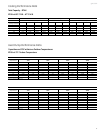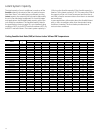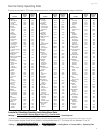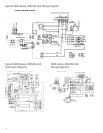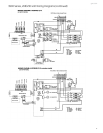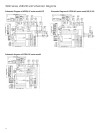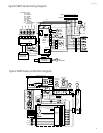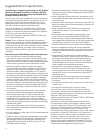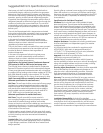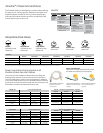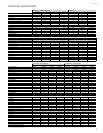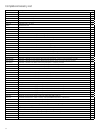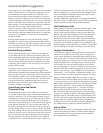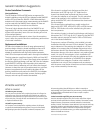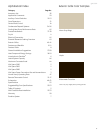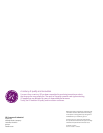
53
ge.com
Suggested Bid Form Specifications (continued)
Heat pump unit shall include Reverse Cycle Defrost that
automatically begins a defrost cycle when microprocessor
determines criteria for defrosting has been met. Defrosting
shall be accomplished by systematically ceasing heat pump
operation, pausing to allow internal refrigerant pressures
to equalize, then operating the compressor with the flow of
refrigerant reversed to allow the hot gas to flow through the
outdoor coil melting the accumulated frost. The unit shall
automatically resume heat pump operation, after pausing
to allow refrigerant pressures to equalize, at conclusion of
defrost cycle.
The unit shall be equipped with a temperature-activated
drain valve to allow water generated in heat pump operation
and defrost cycles to drain into the wall case rather than
being deposited on the outdoor coil.
In the event of compressor failure during heat pump
operation, The unit shall automatically switch to electric
resistance heat to maintain selected room temperature
regardless of outdoor temperatures.
The unit shall have a switch concealed from room occupant
to allow heat pump operation to be overridden and heat
provided by electric resistance heat regardless of
outdoor temperature.
In the event of compressor failure during heat pump
operation, unit shall automatically switch to electric
resistance heat to maintain selected room temperature
regardless of outdoor temperatures.
Specifications for Optional Internal Condensate Removal
(ICR) system for 3900 or 5800 series heat pump units.
The unit shall have a factory-installed Internal Condensate
Removal (ICR) system to permit unit to automatically dispose
of heat pump generated condensate water with no overflow
to outdoors during heating under outdoor ambient of 55°F Dry
Bulb, 90% Relative Humidity; indoor ambient 70°F Dry Bulb,
52% Relative Humidity, for four hours of continuous run time.
(Wall Cases and Grilles are needed for new installations.)
(Alternate specification for steel wall case.)
Wall Case. The wall case shall be constructed of heavy-gauge,
insulated, zinc-coated phosphated steel with a protective
baked-on enamel finish. Bottom critical points of the steel
wall case shall be coated with petroleum microcrystalline
wax for added corrosion protection and shall meet ASTM
B-117, 1800-hour hot air aerated salt spray test.
(Alternate specification for molded wall case.)
Wall Case. The wall case shall be constructed of a
non-corroding fiberglass-reinforced polyester compound.
Cases shall be installed through exterior walls where
shown on the plans and shall be installed per manufacturer’s
installation instructions. In no instance shall fasteners be
used through the bottom in order to retain the water integrity
of the bottom of the wall case.
Outside weather panels shipped with the cases shall remain
in place until the outdoor air louvers and chassis are installed,
at which time they are to be removed and discarded by
the installer.
Outside Grille. Each unit shall be equipped with a standard
exterior grille that has been designed to allow unit operation
in high ambient conditions. Grilles shall be of material and
design specified.
Special grilles or customer louver sections to be supplied by
others will conform to a minimum of 65% free area to allow
for proper unit operation and shall be submitted to the PTAC/
PTHP manufacturer, if requested, for feasibility and airflow
characteristics.
Specifications for Sub-Base (if required)
Sub-Base. Each unit shall have a field-installed UL-listed
electrical sub-base. The sub-base shall be attached to the
lower inside flange of the wall case prior to installation in the
exterior wall. It shall include adjustable screws at the bottom
corners to permit exact leveling of the wall case. The sub-base
shall have a factory-installed receptacle to allow unit line cord
to plug into mating receptacle and shall have a chaseway to
contain and conceal the line cord. The sub-base shall have side
panels adjustable from a minimum of 2-3/8" to a maximum of
13-3/4" to enclose the area under the wall case.
Weather Resistance. Complete unit including outside louver
shall be submitted to an independent agency for weather
resistance tests.
Air infiltration test to be conducted in accordance with
ASTM E283-91. With static air pressure differential of
1.57 lb./ft.
2
(.3" H
2
O) equivalent to 25 mph wind, allowable
air infiltration shall not exceed 7 ft.
3
/min.
Approvals. Units shall be certified under the ARI and cUL
certification program and listed by UL.
Service. Submit complete information with bid covering
service availability to whom service on units will be assigned,
along with complete address and phone number, including
phone number of emergency service personnel.
Start-Up, Adjust, Demonstrate. Contractor shall be responsible
for the initial starting of units, adjustments thereto, etc., to
place the units in required operating condition. Contractor
shall demonstrate to the owner or his representative the
operation of units for both summer and winter functions.
Warranty. The warranty shall be a full one-year parts and
labor on the entire unit, plus an additional full four years
parts and labor for the sealed refrigerating system, including
service call for diagnosis and transportation to and from
service shop (if necessary) at no charge to the customer.
The warranty shall also include a limited second through
fifth year parts only warranty for fan motors, switches,
thermostat, heater, heater protectors, compressor overload,
solenoids, circuit boards, auxiliary controls, thermistors,
frost controls, ICR pump, capacitors, varistors and indoor
blower bearing.
Installation Responsibility. Units shall be installed
according to the manufacturer’s recommendations and the
manufacturer shall not be responsible for unit failure as a
result of improper installation, or unit performance when
installed with accessories not approved by the manufacturer.



